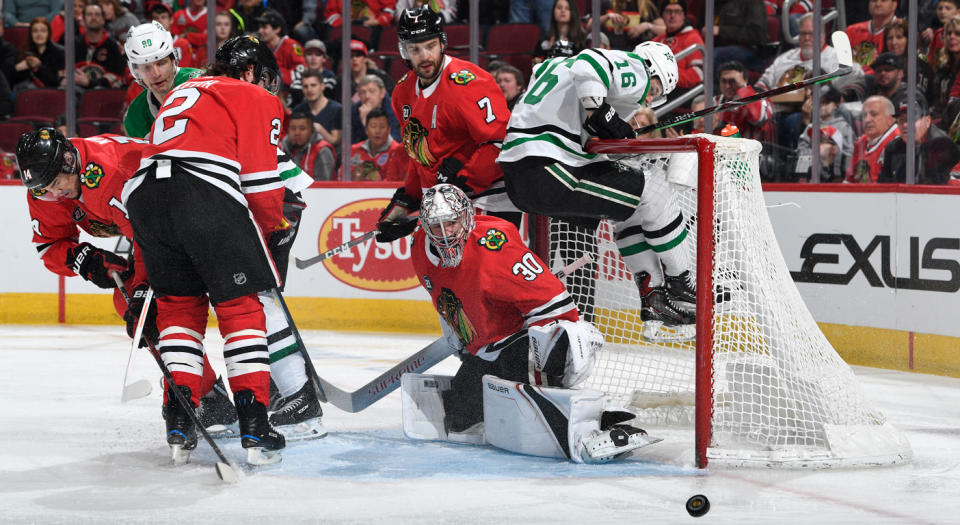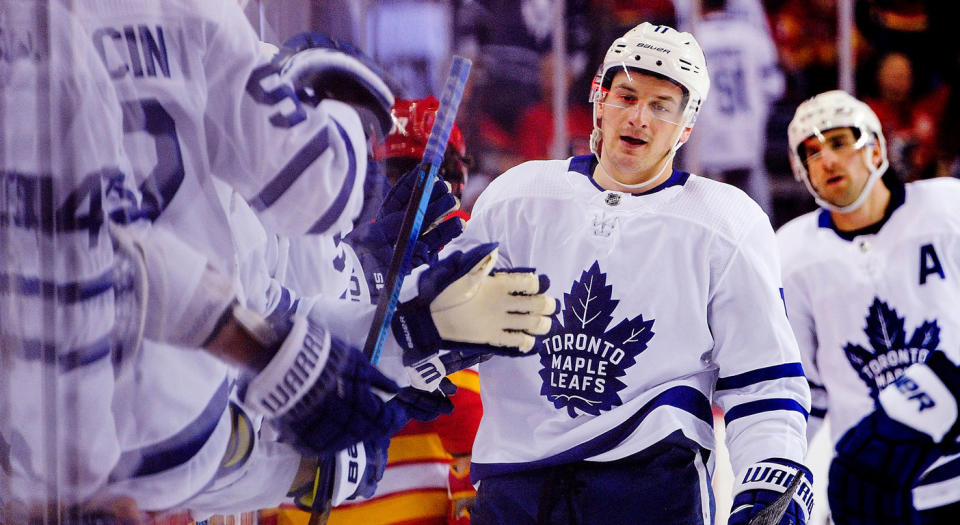Filipovic: On the Blackhawks' matador defense, and how to take advantage of it
This year’s Chicago Blackhawks are the hockey equivalent of the train wreck you just can’t seem to look away from. In the Venn diagram of entertainment and effectiveness, there’s just enough overlap of the two to make it worth our while as viewers.
They’re the closest facsimile to last season’s New York Islanders, serving as the team that’s exceedingly fun to watch despite not actually being all that good. As the eighth ranked offense they have enough talent up front to hold serve in the high scoring back and forth shootouts they routinely find themselves partaking in. But they’re set to miss the playoffs for the second consecutive year anyways, because their defending on the other end of the ice isn’t just porous, it’s historically bad.
We may be living in an internet era where hyperbole is commonplace, but in this case it’s almost impossible to overstate the degree to which the Blackhawks have struggled without the puck. Their play in their own zone has been nothing short of shambolic, as they flop around like a fish out of water in a seemingly hopeless pursuit of the puck. The whopping 310 total goals they’re currently on pace to give up this season would put them behind only the 1999-00 Thrashers, who gave up 313 that year, for the most goals surrendered over the past two decades.

While the play of goaltenders and what’s going on in front of them is inextricably linked, it’s hard to put too much of the blame on Chicago’s netminders here for those jarring totals. Even though the likes of Collin Delia and Cam Ward won’t ever be mistaken for prime Dominik Hasek, putting the brunt of the blame on their doorstep is akin to missing the forest for the trees. They’re 26th in five-on-five save percentage and 29th overall, but they’ve also been tasked with a suicide mission.
According to Natural Stat Trick’s Goals Saved Above Average metric, the two of them plus Corey Crawford have essentially been a net neutral compared to what we’d expect from a league average netminder given the same workload. The bigger and more troubling issue is what’s unfolded in front of them: a comedy of errors resulting in blown coverages, missed assignments, and odd man rushes.
The end result has been an ugly one, seeing their goalies regularly bombarded with shots of nearly unparalleled quality and quantity. Only the Senators have conceded more shots against on a per minute basis, and no team has surrendered more scoring chances and high danger attempts against. The Ducks aren’t lagging too far behind in either respect, but the difference between them and the Blackhawks is that they at least have John Gibson to lean on. Without a goalie that’s routinely capable of standing on his head and stealing games for them, the goals against have been accumulating in bunches:

Let’s put these totals into some further context. The Blackhawks have conceded seven or more goals on eight different occasions this season, which is the exact same number of times they’ve kept an opponent to under two goals. The last time that growingly rare event happened was all the way back on December 21st, when Chicago went into Colorado and held the Avalanche to the lone goal.
From a fantasy perspective, they provide a tasty opportunity for managers that are working the waiver wire to feast on. Essentially everyone that’s crossed paths with the Blackhawks has enjoyed copious amounts of success offensively, and there’s no reason to believe that’ll change as they play out the string in the waning weeks of a lost season. Looking ahead their schedule is littered with opponents that have sparsely owned players now playing prominent scoring roles on their respective teams. Here are a few of those potentially appetizing options that could not only provide value in their upcoming matchups against the Blackhawks, but for the rest of the season as well:
Roope Hintz (0% owned) is a great example of just that, seeing as he’s seemingly come out of nowhere to now ride shotgun alongside Tyler Seguin and Alex Radulov. The beneficiary of a Stars team that’s looking to spread their talent out and become more difficult to defend, Hintz has two goals and 11 shots in the three games he’s played since the promotion. Who knows how long he hangs on to the spot, but for as long as he’s there he’s worth taking a flier on.
Andrew Shaw (19% owned) isn’t a name that you’d typically associate with offense, considering he’s reached 20 goals just once in his career while never topping 40 points. But he’s actually been quite effective this season, trending towards setting new personal highs in both despite having missed a healthy chunk of the campaign. Playing alongside Max Domi and Jonathan Drouin, he’s carved out a spot for himself by doing the dirty work. He retrieves pucks, creates traffic around the net, and parks in the right spots to make himself available to benefit from their wizardry with the puck.
They’ve been absolutely dreadful as a team on the man advantage all year, but at five-on-five only the Lightning, Leafs, Capitals, Penguins and Sharks have generated more offense than the Canadiens have. Shaw has been a big part of that – he’s 13th in goals per hour, and 12th in points per hour. Assuming he keeps his gig in the top-six, there’s no reason to believe he can’t continue being a sneaky source of secondary scoring. And considering how well that trio has played together, there’s likewise no reason to believe he’ll get bumped out of that cushy role.
Fantasy gold comes when talent meets opportunity, which is the intersection that Oskar Lindblom (3% owned) currently finds himself at. Despite the fact that he was a 5th round pick, he’s a player that’s generated a ton of buzz as a prospect because he’s not only produced offensively every step of the way since then but seemingly gotten markedly better every year on his way to the NHL as well. After leading his Swedish Hockey League team in scoring with 47 points in 52 games in 2016-17, he put up 41 points in 62 AHL games as he transitioned to the North American game last year.
After a slow start to the season with the Flyers, he’s really found his stride and taken off in recent weeks. Since the All-Star break he’s seen his minutes get bumped up from an average of 12 to 16 per game, registering five goals and nine points in those 15 games (after just six and 16 respectively in the first 49 prior to the break). What bodes well for him not only sustaining that success but potentially building on it is that he’s been generating a high volume of shots, getting 46 pucks on net in that time. He’s found great chemistry in a spot next to Sean Couturier and Jakub Voracek, who are two players that typically have the puck and love to set teammates up. It’s a great spot for him to finish the year strong, and cement himself as a trendy sleeper candidate heading into next season.
Zach Hyman (36% owned) doesn’t provide a tremendously high ceiling because he doesn’t see any time on the power play, but there’s still value to be squeezed out of a player that sees regular minutes next to Mitch Marner and John Tavares. Because of his defensive work on the forecheck his job is secure, which is a nice luxury considering all of the uncertainty that hovers around most players of similar stature. He’s got a pair of multi-goal efforts in the past ten days, putting up six goals in his last eight games. Considering all of the extra attention Tavares draws as a shooter, and the prolific playmaking ability of Marner (no player has more primary assists at five-on-five than his 32 thus far), Hyman should continue to be the beneficiary of some glorious looks.

While we’re on the Leafs, the same goes for Andreas Johnsson (32% owned) and Kasperi Kapanen (46% owned), both of whom are playing alongside Auston Matthews on a line that’s oozing skill and speed. Johnsson has been hot of late, scoring nine goals and adding five assists in his last 14 games. He’s done most of his damage at five-on-five this year — where he’s 14th in goals per hour and 23rd in points per hour, sandwiched by Claude Giroux and Evgeni Malkin — but it’s worth noting that he’s also seeing time on one of the league’s most deadly power plays now as well. While he’s undoubtedly a fine young player with plenty of high scoring days ahead, before you go taking out another mortgage and selling your assets to buy as many shares of his as you can manage, just a fair warning: a) he’s shooting an inflated 19% individually (which is the ninth highest rate amongst 264 players with at least 100 shots this season), and b) he has a 12.35% on-ice shooting percentage (which is the fourth highest rate of 616 qualified players with a minimum of 300 five-on-five minutes this season).
The opposite of Hyman is Kevin Labanc (18% owned), in the sense that he represents a high ceiling, low floor dart throw for those that feel like swinging for the fences. While he’s currently playing on a line with Tomas Hertl in the top-six, when the Sharks are fully healthy there aren’t enough minutes to go around for everyone to achieve the type of volume of production that they likely could elsewhere. It’s a double-edged sword, though. While that depth of talent restricts the type of reliable usage that you’d look to target for a complementary player like Labanc, it also means that he gets to play with the likes of Joe Thornton and Gustav Nyquist even when he slides back down to his presumed third line role.
Where Labanc can be of particular use is on the power play, where he’s playing the point opposite of Brent Burns. The Sharks man advantage has been lethal this year, clocking in as the fifth most efficient scoring unit, and anyone that sees minutes there will pile up the points. Labanc’s 15 assists there are tied for 30th with names like Mitch Marner and Mat Barzal, and on a per minute basis he’s sandwiched between Keith Yandle and Victor Hedman. Strong company to keep for a player that’s quietly on pace for north of 50 points despite limited exposure.

 Yahoo Sports
Yahoo Sports 
